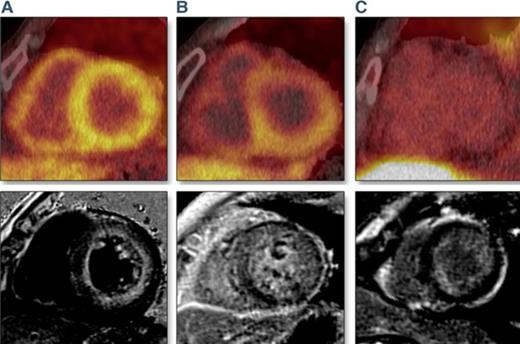-
PDF
- Split View
-
Views
-
Cite
Cite
H Maqsood, H.A Shakeel, M.D Khan, H.F Shoukat, S.A.Y Shah, Prognostication of cardiac amyloidosis by pittsburgh b compound positron emission tomography, European Heart Journal, Volume 41, Issue Supplement_2, November 2020, ehaa946.0295, https://doi.org/10.1093/ehjci/ehaa946.0295
Close - Share Icon Share
Abstract
Regardless of the underlying pathogenesis of amyloid production, cardiac involvement is the leading cause of morbidity and mortality in systemic amyloidosis. In the cardiac variant, there is an extracellular deposition of amyloid substance throughout the heart. The infiltrative process results in ventricular wall thickening with concentric hypertrophy and low cardiac output. The PiB compound has been promising for the detection of amyloid deposits in the brain but it remains unknown whether this noninvasive evaluation can predict the prognosis of patients with cardiac amyloidosis.
This study sought to investigate the efficacy of 11C-Pittsburgh B (PiB) positron emission tomography for prognostication of cardiac amyloidosis by noninvasively imaging the myocardial amyloid deposition.
A total of 33 consecutive patients were enrolled in this prospective pilot study with suspected cardiac amyloidosis. The amyloid deposit was assessed with amyloid P immunohistochemistry in endomyocardial biopsy specimens and was compared with the degree of myocardial 11C-PiB uptake on PET.
It was found that the degree of myocardial 11C-PiB PET uptake was significantly greater in the patients of cardiac amyloidosis compared with control group subjects and was parallel with the degree of amyloid deposit on histology (p<0.001). When the cardiac amyloidosis patients were divided into tertiles by the degree of myocardial 11C-PiB PET uptake, patients with the highest PiB uptake experienced the worst clinical event-free survival (log-rank p=0.013). The clinical outcome was significantly predicted by the degree of myocardial PiB PET uptake on multivariate Cox regression analysis (adjusted hazard ratio: 1.191; 95% confidence interval: 1.062 to 1.340; p=0.005).
Our study concludes that the noninvasive evaluation of myocardial amyloid load by 11C-PiB PET reflects the degree of amyloid deposit and is an independent predictor of clinical outcome in cardiac amyloidosis patients.

11-C Pittsburgh B PET imaging
Type of funding source: Other. Main funding source(s): Self funding



